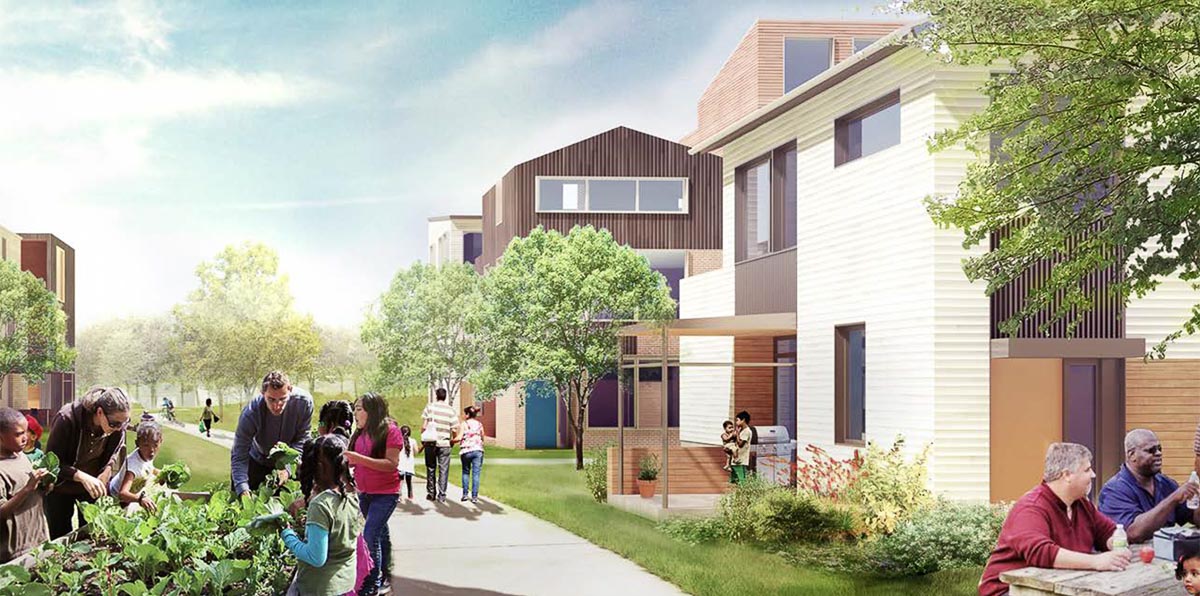This year’s top priority for the Buffalo Bayou Partnership, best known for beautifying the prosperous west side of the historic bayou, is mixed-income housing.
“You might ask why,” said Anne Olson, president and CE0 of the Partnership.
That first massive project, from Shepherd Drive at the edge of River Oaks through downtown, is done. As the Buffalo Bayou Partnership staff focuses on their next, more complicated chapter — developing the east side of the bayou through Second Ward, Fifth Ward and all the way to the Port of Houston Turning Basin — they are keeping in mind the hundreds of conversations they’ve had with residents there. Many of them fear bayou improvements will mean they’ll be priced out of their own communities.
“The need for affordable housing keeps coming up,” Olson said. “While we can’t stop gentrification from happening, we felt this was one way we could contribute to stabilizing the neighborhoods.”
Groundbreaking for the first phase of Lockwood South, the Partnership’s new apartments in the Second Ward, is scheduled for June. Right now, the 18 acres on the southern shore of the bayou are imminently forgettable — filled with untamed brush and excavation dirt. But Ian Rosenberg, project manager, says the area soon will be transformed by 80, one-, two- and three- bedroom units, landscaping, access to parks, hike and bike trails and the bayou itself. The work will be done in partnership with Brinshore, a Chicago-based development company.
Construction on that first phase is expected to cost $25 million and take 18 months. Housing in future phases will add another 270 mixed-income units, including some single-family homes.
As they plan, Rosenberg says, they strive to create a community for people of all incomes, ages and backgrounds.
Community activist Jessica Castillo Hulsey is looking forward to the new apartments and is especially interested in plans to build single-family homes.
For years, Hulsey has watched as developers have mowed down bungalows and replaced each one with multiple pricy townhomes.
Those modest, frame houses once were iconic in the Second Ward and sheltered many generations of young families, according to Hulsey. She would like to see them preserved or replaced in kind.
“Don’t erase our history,” Hulsey said. “Respect the names of those who came before us.”
When Hulsey was young and just starting on the activism path, she sought the advice of a local civic leader in his 80s. “As a matter of fact,” Hulsey said, “his name was Tony Marron.”
Hulsey is proud to say that Tony Marron Park in the Greater East End is named for him, and it’s one of the green spaces that will be expanded and improved as part of the Buffalo Bayou East project.
“They are givers,” she said of her Buffalo Bayou Partnership friends.
“Don’t erase our history. Respect the names of those who came before us.”
When work on Buffalo Bayou East is complete, there will be more than 40 miles of new and improved waterfront trails and on-and-off street bikeways, more than 200 acres of parks and public spaces, seven new boat landings and seven new pedestrian bridges. All of that is expected to take 20 years or more.
In the short term, however, there is still much to look forward to:
► A pocket park at Japhet Creek in the lower Fifth Ward. The natural tributary to Buffalo Bayou is a treat, a touch of wilderness right off Clinton Drive. José Solís, the Partnership’s project manager for planning and construction, said restoration work should start in the next two to three months. They’ll be removing trash and invasive species, then adding signage and rebuilding an existing walking path. Phase two will feature a boardwalk trail to the bayou.
“Our goal is to get people to the water,” Solís said.

Restoration work to build a pocket park at Japhet Creek should start in the next two to three months.
Photo courtesy of Buffalo Bayou Partnership
► Hidalgo Park, owned by the city, and Yolanda Black Navarro Buffalo Bend Nature Park, owned by the county, will be connected by a trail to create one large green space. Solís said he hopes that the work near the turning basin will begin in the next year or two. It depends on when grant funding is released, he said.
► Wharf and dock reconstruction along a barge terminal that is part of Turkey Bend, an abandoned industrial site in the Second Ward. The complex includes a warehouse with 52,000 square feet on Navigation and a second, smaller warehouse along the waterfront. By the end of 2021, Solís hopes repairs and upgrades to the wharf will be underway.
► Filling the gaps in hike-and-bike trails from downtown to the turning basin. That work should begin in the next 12 months.
As for Tony Marron Park, which is precious to Hulsey and Solís as well, there is still much to be done before breaking ground in three to five years.
“Tony Marron is the green heart of the master plan, the signature park right in the middle of everything,” Solís said.
It’s located on the south side of the bayou, but there will be a bridge stretching to the north shore. And the park will more than double in size, growing from 20 acres to 43.
Park visitors will see that the bayou is deeper and wider at that point and looks and feels like a bona fide river.
“Historically, these neighborhoods have been detached from the bayou, and more than anything, we’re trying to give the bayou back to the people,” Solís said. “We have another real big goal — in the past the Fifth Ward has been isolated, separated from the Greater East End. We’d like to create green spaces for both sides of the bayou and help the communities connect, too.”

